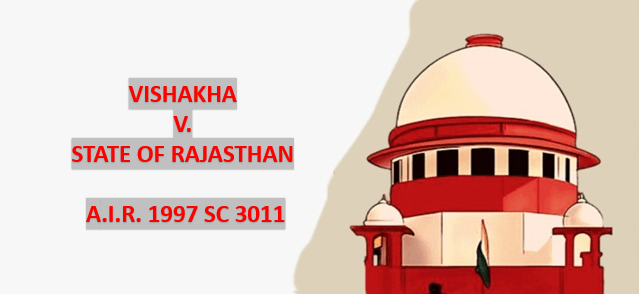
VISHAKHA V. STATE OF RAJASTHAN A.I.R. 1997 SC 3011
| OVERVIEW OF THE CASE | |
| Case Name | Vishakha and ORS. V State of Rajasthan |
| Citation | A.I.R 1997 SC 3011 |
| Date of Judgement | August 13, 1997 |
| Court | Supreme Court of India |
| Petitioner | Vishakha and ORS. |
| Respondent | State of Rajasthan |
| Bench | J.S. Verma (Chief Justice), Sujata V. Manohar, B.N. Kirpal |
Introduction
I raised up my voice—not so that I can shout, but so that those without a voice can be heard. We cannot all succeed when half of us are held back.
-Malala Yousafzai
Malala Yousafzai gave voice to many unheard women, and in the late 1990s there was a woman who spoke out against sexual harassment in the workplace. In the current situation, we all have the necessary legislation, Sexual Harassment of Women at the Workplace, 2013, to make claims in cases of harassment or to protect and give women a safe workplace. However, have you ever considered the scenario from 1992—nearly 15 years prior to 2013—in your mind? This instance of discrimination against women is illustrated in the case of Vishaka v. State of Rajasthan. The Supreme Court decided the Vishaka guidelines in this case for the protection of women from sexual harassment at work since specific law was required in this area.
Facts of the case
To provide a better understanding, it is vital to present the case’s facts in depth at the outset. First off, the alleged violent gang rape of a lady in a Rajasthani village served as the initial impetus for this campaign for gender justice. A social worker named Bhanwari Devi was gang-raped for her selfless efforts to stop child marriage. Unfortunately, this criminal case was dismissed [1] due to insufficient proof of the offence. However, this episode gained traction among numerous social activists and NGOs, reinforcing the need for particular legislation for sexual harassment of women at the workplace in light of gender equality. Following that, this writ petition was submitted by a number of NGOs and social activists under Article 32 on the grounds that the Constitution’s Articles 14, 15, and 21 had been violated.
Issues Raised
●Whether sexual harassment at work violates Articles 14, 15, and 21 of the Constitution’s Fundamental Rights?
●If there are no suitable domestic legislation, can an international convention be applied
●Is it necessary to establish laws that must be followed in light of workplace sexual harassment?
Contentions
●Arguments from the petitioner
The ‘Vishakha’ organisation and other organisations filed the writ petition, arguing that the sexual harassment of women at work violates their fundamental rights as guaranteed by articles 14, 15, 19(1), and 21 of the Indian Constitution. They asked the court to establish rules for combating sexual harassment at work. It’s important to comprehend the true meaning of gender equality.
●Arguments from the respondent
In this case, the solicitor general made an extraordinary move. The state backed the petitioners with the respondent’s approval. In order to stop sexual harassment and create a rule to prevent it, the respondent worked with the court to develop a workable plan.
Judgement
●J.S. Verma, the chief justice, delivered the verdict in this case. According to the court, every profession, trade, or occupation is required under article 14(2), 19(3) (1) (g), and 21(4) of the Indian Constitution to provide a safe working environment for its employees. The right to life and the right to a dignified existence were impeded. The availability of a safe working environment at the place of employment was the fundamental necessity.
●The word “sexual harassment” has been clearly defined by the Supreme Court. Sexual harassment was defined as any physical contact or activity, the display of pornography, offensive remarks or misbehaviour, or any sexual urge towards women or sexual favours.
●According to the Supreme Court, women have a basic right to be free from sexual harassment at work. It also presented a number of significant instructions for the workers to go by and prevent workplace sexual harassment of women.
Conclusion
India is making great strides towards its development objectives, and more women are working. Recognizing the right to protection against sexual harassment is an essential component of safeguarding women’s human rights. All of this is a step toward ensuring women’s independence, equality of opportunity, and the right to a dignified workplace. Workplace sexual harassment is a societal issue that has to be addressed. It is vital to enhance employer and employee knowledge of the occurrence of various types of sexual harassment at work, as well as preventative measures and the legal framework for preventing and treating sexual harassment.
Pandit Jawaharlal said- “you can tell the condition of a nation by looking at the status of its women”.
Mahatma Gandhi once said- “the day a woman can walk freely on the roads at night, that day we can say that India has achieved independence”.
Written by: Ishita Singh, Chotanagpur Law college Ranchi, 2nd semester, an intern under legal Vidhiya.




0 Comments